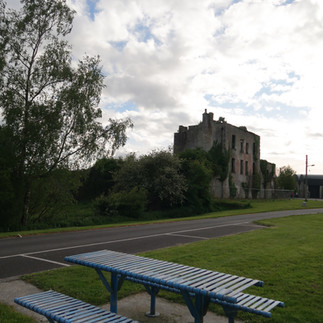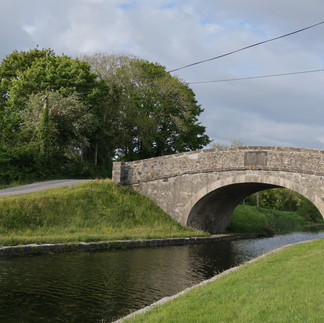Escape into nature on The Grand Canal Way
- Karyn Farrell
- Jun 2, 2021
- 6 min read
Updated: Sep 21, 2024
Published in the Your Ireland supplement June 2021 - a comprehensive guide to summer breaks. A Celtic Media Group special edition published with Anglo Celt, Meath Chronicle, Offaly Independent, Westmeath Examiner, Westmeath Independent and Connaught Telegraph Link to full supplement here:
Full text and an additional gallery of images below

The Grand Canal Way
Lovers of the great outdoors will enjoy meandering along The Grand Canal Way, a 131-kms National Waymarked Trail connecting Ringsend in Dublin’s docklands to Shannon Harbour in Offaly. Traversing Dublin, Kildare and Offaly, this historic trail is a mostly off-road stretch of flat and well-surfaced paths suitable for both cyclists and walkers, and people of all ages and abilities.
The route is a tranquil one through unspoiled countryside with rolling hills, a patchwork of green fields, pretty waterside villages, well-preserved bridges and working locks. Construction of the Grand Canal began in 1757 and was completed in 1804. Though closed to commercial traffic since 1951, it has since been developed into a wonderful public amenity and there is no better way to experience it than on foot or bike. It can be done in sections or all at once.
The 71-kilometre stretch of the route between Edenderry and Shannon Harbour has a surprisingly high number of places worthy of a pit-stop. Here are just a few…
Blundell Aqueduct
Known locally as ‘The Tunnel’, this squared stone aqueduct dates to 1793 and is a unique feature in the Offaly landscape: a structure which carries the canal above the road. A major obstacle in the initial construction of the Grand Canal was the crossing of the Bog of Allen which lay directly in its path, overcome by building up banks for the water to flow through on top of the surrounding bog land. What we see today is a raised canal running over the Edenderry-Rathangan road, surrounded on both sides by lush banks of greenery and with gorgeous views in both directions.
Ballycommon Bakehouse
You don’t need to venture far off-route for your caffeine fix – this little gem of a family-run café is right on the canal, not far from Daingean, and sells a delicious range of baked goods, sandwiches and other treats. Handmade with love and served with a huge smile, it’s no surprise that people cycle from afar to stock up for their journey here. Coffee is from the excellent Mullingar roastery Bell Lane.
Boland’s Lock

Located at the 26th lock is one of the most distinctive architectural features on the canal – a delightful oval-shaped lock keeper's house. Built c.1800, it has a conical slate roof, square-headed windows and a projecting bow to the front and rear of the house, with castellated detailing at the top. It’s a striking sight on approach: pristinely maintained and brightly painted, looking every inch like a postcard.
Ballycowan Castle

A short distance westward stands the imposing ruins of Ballycowan Castle, its six tall distinctive chimneys visible from afar. It pre-dates the construction of the canal, built c. 1589 by Thomas Morres. The structure we see today was extended by Jasper Herbert in 1626 on land granted to him during the Plantations - the tower was added at this point. The castle remained in Herbert ownership until 1666 when it passed to the Earl of Mountrath.
Its original defensive function is not in doubt: a lookout point projects from the north-east corner of the building, and there is an opening above the entrance door through which objects and liquids could be dropped on enemies below, grimly known as ‘murder-holes’. Now on private land, access is only with permission of the landowner. The best viewing point is from the canal bridge where you really get a sense of its scale: a dominating feature in the landscape whose chimneys rise above the height of the surrounding trees.
Rahan Early Christian Monastic Site

You’ll have to come off the Grand Canal to visit this 5th century monastic site, but the mini detour is worth it. A roadside signpost points the way to a striking whitewashed church: an unusual example of an Irish Romanesque building.
It boasts a distinctive 13th century circular window to the rear which is unique in Ireland. Something to look out for are the exquisite Romanesque carvings surrounding a 15th century ogee window: pop over the little stone stile to take a closer look. Though faded with time, you can still make out mythical beasts and animal-head decoration. Stained-glass tracery windows and doors with chevron detailing are other attractive features.
The same Romanesque design is reflected in the second church on the site. Located in a field to the rear, it dates to the later Medieval period and is now an attractive stone ruin. Some of the details from the earlier church are replicated here, including the geometric chevron pattern above the door and the beautiful carvings on the ogee window to the rear.
Pollagh

Travelling west, your next stop off should be Saint Mary's church in the lovely canal-side village of Pollagh. Built c. 1907, it has an unusual V-shaped plan with a central tower and a pyramidal roof. It’s an important church architecturally for its converging transepts, originally to facilitate the separation of men and women while allowing both to see the altar.
The interior is an unexpected artistic treasure-trove. Above the altar are two beautiful stained-glass windows from the Studio of Harry Clarke. Also of significance are the altar, tabernacle, lectern and chair, made from local bog yew by renowned sculptor Michael Casey and students of The Celtic Roots Studio.
Overlooking the church is Plunkett Bridge, one of the most attractive and prominent features on the Grand Canal. A single-arch masonry canal bridge, it dates to 1809 and the views on approach from the canal banks are something special, particularly in summer. It’s easy to see why this stretch is so popular with walkers and cyclists. The canal twinkles in the sun as it weaves its way though a vivid green landscape, and the church and bridge add a picturesque note.
Lough Boora Discovery Park

A worthwhile detour from Pollagh is Lough Boora Discovery Park, one of the top places to visit in the midlands, and always a winner with adults, kids, nature enthusiasts and art lovers alike. What was once an area of bog-land has been reclaimed and developed into a wonderful eco-tourism site, teaming with birds and all types of plants and wildlife.
The park is crisscrossed with a number of cycling and walking trails but aside from that, few man-made interventions have meant a retention of a certain wild beauty, apt for its location.
There are loads of reasons to come here but the wonderful Sculpture Trail is one of the biggest draws. Grab yourself a map at the visitor centre: there are twenty-four artworks to find, some monumental, others ephemeral which have almost become part of the landscape as time and weather-conditions have changed their nature. Kids will adore it and will relish the chance to run ahead and find the next work of art.
Clonony Castle

Located between the River Brosna and the Grand Canal, this 15th century tower house is an impressive sight on approach. Enclosed within an immense outer wall and surrounded by a moat, it was built as a stronghold for the MacCoughlan clan and some defensive features are still visible, including gun loops and a murder hole above the entrance gate. History fans will be drawn to the tombstone within the grounds marking the burial place of Mary and Elizabeth Boleyn, nieces of Anne Boleyn, who lived out the final years of their lives in exile in this castle.
The tower house is one of the best examples of the Tudor style in Ireland and has been painstakingly restored in recent years, surrounded by beautiful gardens in full flourish. It is now in private hands but open to visitors at weekends and Bank Holidays, and by appointment every other day. More details on their Facebook page here
Shannon Harbour

At the end of the route lies Shannon Harbour, a picturesque little village at the confluence of the canal, the River Shannon and the River Brosna. Founded in 1830, it was purpose-built and operated as a trans-shipping centre.
The ruins of many grand stone buildings from this time are still visible and strikingly beautiful against the skyline. The Grand Hotel dating to 1806 stands as a ghostly but magnificent remnant of its past: a three-storey mansion overlooking the harbour.
The pace of life is slow and relaxed here and the scenery is glorious. Pristinely maintained, it has green areas and flowers everywhere with brightly painted benches to sit and enjoy the views.
Visitors will enjoy walking along the tranquil canal bank to admire the colourful houseboats and pleasure boats berthed in the marina – one of the best views is from beneath Griffith Bridge as the water shimmers and overhanging trees cast long reflections. It comes alive in summer and it’s not difficult to see why – it’s an idyllic place to enjoy a lazy few hours and is certainly a contender for one of the best places in the midlands to catch a sunset.
For more information on the Offaly Grand Canal canal, check out the Visit Offaly webpage here.
Happy and safe travels this summer xx













































































































































Comments